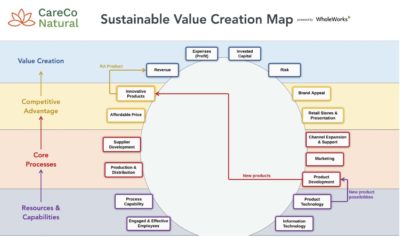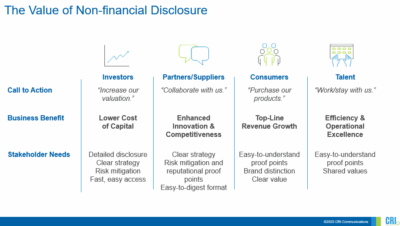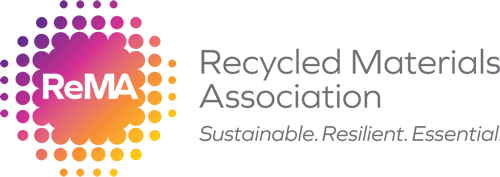Value Creation
Mapping Your Sustainable Value Creation
While much of the focus on sustainability is on risk reduction, increasingly there is a recognition of the value that a company can create from sustainability. Materiality, strategy and goal-setting can all be used to create new value for companies. In fact, 98% of CEOs now feel it is their role to make their business more sustainable.[1]
WholeWorks LLC has developed a tool to help companies find value creation opportunities through sustainability strategies and program development.  Their program is based on the notion that these opportunities are often missed because managers fail to recognize the potential of sustainability to stimulate innovation, increase revenues, decrease costs, reduce risks, attract capital, and strengthen the business in other ways (see the Whole Works White Paper). Their concept uses the Sustainable Value Creation Map to help companies identify how a sustainability initiative is connected to the business’ resources, capabilities, core processes, and competitive advantages.
Their program is based on the notion that these opportunities are often missed because managers fail to recognize the potential of sustainability to stimulate innovation, increase revenues, decrease costs, reduce risks, attract capital, and strengthen the business in other ways (see the Whole Works White Paper). Their concept uses the Sustainable Value Creation Map to help companies identify how a sustainability initiative is connected to the business’ resources, capabilities, core processes, and competitive advantages.
Making sustainability an integral part of the business requires understanding how sustainability initiatives can strengthen a competitive strategy and create financial value. Their accelerates the ability of professionals and leaders to integrate sustainability issues across their companies, creating value and transforming traditional business to sustainable.
For more information, please refer to the September 2023 workshop on Value Creation (download slide deck) or the August 2025 webinar which featured stories of how two ReMA member companies have created value through sustainability initiatives:
Communication as Value Creation
Once companies identify where sustainability creates value—whether through innovation, efficiency, or market access—the next challenge is communicating that value clearly, credibly, and consistently. Strategic sustainability communications is not just a reporting obligation, but a form of value creation.
As expectations around transparency and legal responsibilities rise, companies must invest in strategic messaging and third-party certifications that back their claims and amplify their credibility.
Communication is no longer just the “last step” after operational improvements, but the driver of value in and of itself. Effective communication:
- Unlocks market access and procurement preference, especially where certifications are required by buyers
- Attracts investors, especially when backed by credible data and certifications
- Builds brand loyalty, particularly among values-driven consumers
- Differentiates your offering in crowded markets
Types of Sustainability Communication
Companies use different forms of communication to reach stakeholders with distinct expectations:
- Marketing Communication targets customers and the general public through brand-driven advertising.
- Advocacy Communication focuses on shaping policy or regulatory outcomes.
- Reporting Communication typically addresses financial, environmental, or contractual disclosures.
Why Non-Financial Disclosure Matters
Robust ESG communication creates business value across stakeholder groups:

Source: CRI Communications, April 2025 ReMA Webinar Presentation
Best Practices for Sustainability Communications
- Use reporting as a storytelling opportunity—one that reflects your unique business model, goals, and stakeholders.
- Develop a suite of communication tools, not just one report. Tailor outputs to meet the needs of investors, regulators, customers, and employees.
- Ensure consistency across channels and formats, avoiding conflicting messages across marketing, advocacy, and formal disclosures.
- Focus on progress, not perfection. Stakeholders value honesty, clarity, and alignment with core values and business strategy.
Certification & Eco-Labels: Keys to Credible Sustainability Messaging
As sustainability messaging becomes more prominent, the demand for credible sustainability claims is rising rapidly. Certifications now play a critical role in shaping sustainable communication strategies—not just as company achievements, but as essential risk management and value enhancement tools.
Why Consider Certification
- Growing Demand for Transparency: Today’s audiences—ranging from consumers and investors to regulators and suppliers—expect more than broad, unsupported sustainability claims. There is a rising demand for credibility and transparency, with stakeholders scrutinizing environmental and social impact through a more informed lens.
- Heightened Regulatory and Legal Pressures: Greenwashing litigation is on the rise, with plaintiffs finding themselves increasingly successful in proving false or misleading environmental claims. Certifications help validate messaging, supporting organizations in demonstrating compliance and defending against legal challenges. Regulatory frameworks like the amended Canada Competition Act highlight the need for increased diligence in certification and claim substantiation.
For more on the Canada Competition Act, see ReMA’s November 2024 Policy & Regulatory update webinar.
- Trust and Credibility: Certifications provide trust and credibility to sustainability narratives, especially when compared to self-declared claims. Consumers overwhelmingly place more confidence in products and companies that are verified by credible third-party organizations. In a crowded and competitive market, certification can be the factor that tips the scale in favor of one brand over another, thus increasing your business’ value overall.
Understanding the Certification Process
Certification is a form of conformity assessment that must come from an independent third party. There are multiple levels of assessment, each carrying different levels of credibility:
- First-party (self-declaration): No impartiality; companies cannot objectively validate their own claims.
- Second-party (supplier audits): Limited impartiality; assessments conducted by parties with vested interests.
- Third-party certification: Independent and impartial assessment.
- Third-party certification by an accredited body: Fully independent, impartial, and subject to re-certification and oversight.
The general certification process includes:
- Application & Eligibility: Determining whether the product, process, or system meets baseline requirements.
- Evaluation: Conducting audits, inspections, or tests.
- Decision: Issuing certification if compliant or initiating corrective actions if not.
- Surveillance: Ongoing monitoring and re-certification to ensure continued compliance.
Certification is not limited to physical products. It applies across a wide range of activities including processes, people, systems, and events. This makes certification especially valuable in operations where non-physical or service-based sustainability impacts are harder to measure.
Some examples of certifications include:
- Products and Materials: Verifies the environmental attributes of materials, components, or finished products (e.g., recycled content).
- Facilities and Installations: Confirms compliance of buildings, equipment, or installations with environmental or safety regulations and industry standards.
- Personnel Qualifications: Certifies individuals for specific roles, making sure they meet sustainability-related competencies or technical standards.
- Events and Operations: Demonstrates that events or business operations follow specific sustainability practices.
- Business Processes and Systems: Evaluates safety, environmental performance, and regulatory compliance of operational systems or management processes.
- System Compatibility and Risk Mitigation: Ensures that components within a broader system work together to reduce environmental or safety risks.
- Project-Level Standards: Confirms that projects (such as carbon offsets) align with recognized principles, methodologies, and third-party standards.
Sustainability Messaging: What the Research Says
As sustainability becomes more influential on consumer decisions, certifications are proving their worth in market dynamics. The Sustainable Market Share Index, which tracks consumer behaviors regarding sustainability, found that the share of sustainability-marketed products grew substantially over the last decade. Even amid inflation, consumers are increasingly choosing sustainably marketed and store-brand products over conventional alternatives. Sustainably marketed products are growing 2.3 times faster than conventionally marketed products, even with an average price premium of 26%. Store-brand market share has also grown steadily since 2020, surpassing its pre-inflation average of 18%.
Conventional products are losing ground, while sustainably marketed and store-brand products are gaining share. This shows that consumers will continue to choose sustainability, especially when claims are meaningful and clearly communicated.
People resonate most with sustainability messaging that is personal, tangible, and directly relevant to their lives or responsibilities. While this is often discussed in terms of consumer behavior, these insights can apply broadly to many stakeholder groups: from neighboring businesses and community members to policymakers and local officials.
If a company can make only one point in their marketing, it should focus on functionality, or why the product or service is valuable in its category. If more messages are possible, they should be sustainability claims that showcase the company’s commitment to the audience’s environment.
Messages that resonate most:
- Health: Fewer chemicals, better nutrition, etc.
- Wealth: Energy savings, cost efficiency, etc.
- Personal world: Protecting children, animal welfare, supporting local farmers, etc.
Messages that resonate less—unless clarified:
- Scientific causes or abstract data
- Traceability (unless connected to a clear consumer benefit)
- Packaging claims (unless it’s made from 100% recycled materials or tied to a WIIFM—”what’s in it for me”—message)
Clarity, specificity, and consumer relevance are key. For example, saying that a bottle is “made from 100% recycled plastic that helps remove 2 million tons of ocean-bound plastic annually” has far more impact than simply stating “made from recycled plastic.”
Note: Content for this section was derived from ReMA’s April 2025 Sustainability Webinar Series session, with guest speakers Kitsie Riggall of CRI Communications, Dr. Anastasia Behr of UL Solutions, and Randi Kronthal-Sacco of NYU Stern Center for Sustainable Business.
Direct Value Creation? A Look at Carbon Credits & Offsets
The Environmental chapter discusses what Carbon Credits and Carbon Offsets are, and how they should be used within an emissions inventory.
But can recyclers also sell carbon offsets, as a way of directly creating value from their environmentally beneficial activities?
Technically – the answer is probably “yes”. However, the cost and effort required may be greater than the economic benefits, and the scale needs to be large enough to capture the complete value chain where the additional and permanent carbon emissions offsets would be realized for sale into the voluntary marketplace.
ReMA’s Carbon Credits & Offsets presentation walks through this question in more detail.
